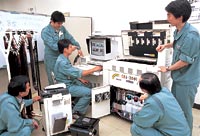 |
|
NIPPONIA No.20 March 15, 2002
|
|

 |
 |
|
Sweet Sounds from Music Boxes, for the World Market
Sankyo Seiki Manufacturing Co., Ltd.
Written by Fukumitsu Megumi, Photos by Yoshihara Akemi
|
|
The rallying cry was "The Switzerland of the Orient!" When Sankyo began production in 1946, the year after the end of World War II, its goal was to make Japan world famous for music boxes. The melody it chose for its first production was the Japanese children's song, Chocho (Butterflies).
At the time, all music boxes were made by hand, but before long, Sankyo became the first company in the world to mass-produce them. Around 1990, when its business peaked, it enjoyed 90% of the world market for music boxes. Today, it is responsible for almost 50% of global production.
Yamada Akihiro from Sankyo's public relations department told me, "The music box was invented in Switzerland in the 19th century. After that, the pins that pluck the tongues were always inserted by hand. But then we developed a mechanical system that strikes from the underside. This made it possible to mass-produce music boxes and sell them cheaper. They used to be beyond the reach of the general population, but not any more."
Sankyo introduced other innovations as well. For example, the company offers a spring mechanism that keeps playing the music at the proper speed until it stops completely, and even owns the rights to edit some songs to suit the music box. Sankyo has also used its expertise as a maker of music boxes to manufacture industrial robots. And the company now sells music box melodies to mobile phone customers who use them in phones to indicate an incoming call. This latest development has created considerable interest.
|

|
|
Yamada Akihiro of the company's PR department: "You might say we make products, but we think of ourselves as producing culture."
|
|
 |
| |
|
Photo Processing Machines Used Worldwide
Noritsu Koki Co., Ltd.
Written by Sakagami Kyoko, Photo by Moritake Takashi
About half of the world's photo processing machines are made by one company, Noritsu Koki. The machines use what the company calls the Quick Service System (QSS). The first machines were sold in 1979, and greatly reduced photofinishing time.
Azuma Yoshifumi of the company's R&D headquarters says, "In the old days, a photo shop would send your film to a large developing lab, so you couldn't see your pictures for three or four days. With the advent of QSS, you can see them in almost no time at all."
|

|
The most dramatic aspect of QSS technology is that every process, from developing the negative to printing the photo, is no longer done by different devices, but by a single photofinishing machine. And the machine doesn't need much space, so even a small store can find the room for one.
The company's founder and current president, Nishimoto Kan-ichi, opened a small photo studio in the city of Wakayama after World War II, and was soon inventing a number of photofinishing devices to boost efficiency. The most famous of these, the first QSS minilab, was installed in a photo shop in Niagara Falls, Canada, near the falls. The tourists were most impressed. This Japanese technology made waves overseas before it did in Japan, and it is now used in photofinishing shops worldwide. 
|
 |



